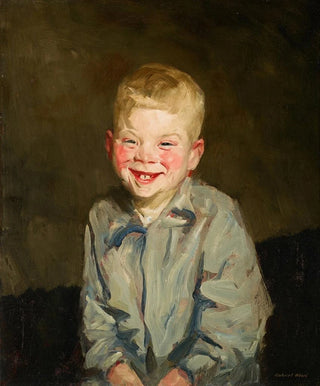Art print | Laughing Boy - Robert Henri


View from behind

Frame (optional)
In the world of art, some works manage to capture the very essence of humanity, transcending time and space. "Garçon qui rit" by Robert Henri is one of these memorable creations. Created in the early 20th century, this painting is a celebration of youth and innocence, a snapshot of pure and uninhibited joy. The sparkling gaze of the young boy, his relaxed posture, and the brightness of his smile invite the viewer to immerse themselves in a universe where lightness and cheerfulness reign supreme. The piece evokes an immediate emotional connection, encouraging everyone to remember moments of simple happiness, shared laughter, and childhood memories.
Style and uniqueness of the work
Robert Henri's style is distinguished by its bold approach and expressive use of color. In "Garçon qui rit," vivid and luminous hues capture natural light, creating a vibrant and dynamic atmosphere. The artist, a member of the Ashcan School movement, focuses on everyday life and ordinary subjects, elevating them to an almost poetic dimension. The boy's face, with its delicate features and radiant smile, is the focal point of the piece, while the blurred background helps to emphasize the presence of the subject. Henri manages to infuse life and personality into his characters, making each work unique. This painting, in particular, illustrates his talent for capturing the moment, revealing an emotional depth that resonates deeply with the audience.
The artist and his influence
Robert Henri, born in 1865, is an iconic figure in American art. As a leader of the Ashcan School, he played a crucial role in the evolution of American painting in the early 20th century. His commitment to depicting urban life and its inhabitants paved the way for many contemporary artists. Henri believed that art should be accessible and relevant, a philosophy reflected in his choice of subjects and style. He was also a mentor to many young artists, sharing his passion for authentic expression and capturing reality.

Matte finish

View from behind

Frame (optional)
In the world of art, some works manage to capture the very essence of humanity, transcending time and space. "Garçon qui rit" by Robert Henri is one of these memorable creations. Created in the early 20th century, this painting is a celebration of youth and innocence, a snapshot of pure and uninhibited joy. The sparkling gaze of the young boy, his relaxed posture, and the brightness of his smile invite the viewer to immerse themselves in a universe where lightness and cheerfulness reign supreme. The piece evokes an immediate emotional connection, encouraging everyone to remember moments of simple happiness, shared laughter, and childhood memories.
Style and uniqueness of the work
Robert Henri's style is distinguished by its bold approach and expressive use of color. In "Garçon qui rit," vivid and luminous hues capture natural light, creating a vibrant and dynamic atmosphere. The artist, a member of the Ashcan School movement, focuses on everyday life and ordinary subjects, elevating them to an almost poetic dimension. The boy's face, with its delicate features and radiant smile, is the focal point of the piece, while the blurred background helps to emphasize the presence of the subject. Henri manages to infuse life and personality into his characters, making each work unique. This painting, in particular, illustrates his talent for capturing the moment, revealing an emotional depth that resonates deeply with the audience.
The artist and his influence
Robert Henri, born in 1865, is an iconic figure in American art. As a leader of the Ashcan School, he played a crucial role in the evolution of American painting in the early 20th century. His commitment to depicting urban life and its inhabitants paved the way for many contemporary artists. Henri believed that art should be accessible and relevant, a philosophy reflected in his choice of subjects and style. He was also a mentor to many young artists, sharing his passion for authentic expression and capturing reality.






